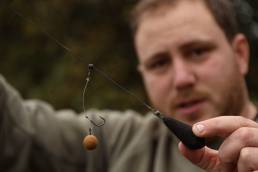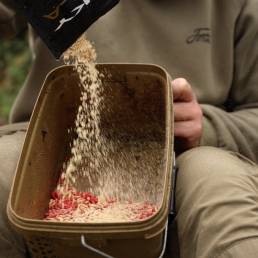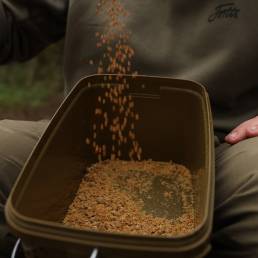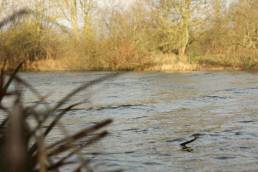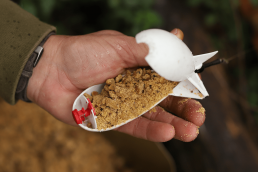
Lance Barton highlights key changes he made in his baiting approach to complete a successful season’s angling, accounting for some incredible carp from both Linch Hill and a local club water.
LANCE BARTON HIGHLIGHTS KEY CHANGES HE MADE IN HIS BAITING APPROACH TO COMPLETE A SUCCESSFUL SEASON’S ANGLING, ACCOUNTING FOR SOME INCREDIBLE CARP FROM BOTH LINCH HILL AND A LOCAL CLUB WATER.

I guess everyone’s spring this year was a little bit different to what they imagined it to be, but without getting into the nitty-gritty and caught up in the pandemic, my plan was to tackle Stoneacres on the Linch Hill complex. After the initial sessions and time on the lake, the visibility drastically changed, and without knowing the lake and the spots, finding them with the clarity being as bad as it was would pose a problem. So, I decided to make the most of the ticket and look on both Willow and Christchurch too, but mainly ‘Church. When it comes to choosing a tactic for the spring, I tend to arm myself with Chods and attractive single hookbaits, either boosted Krill ones or a duller tone like the pastel coloured Mulbz. They’re just waking up from their winter slumber and will be quite lethargic, meaning a nice single hookbait will probably be enough to catch them off guard. Whether they’re sat in the weed or over cleaner/silty ground, the Chod will be presented, and the rig will be prime for a bite from whatever comes to investigate. Once the weather is on your side and the carp are looking more active, that’s when I’ll think about introducing a good quality and attractive bait, like The Krill Active. Targeting the gravel areas to make my bait the feature, with not only the attractiveness but the quantity too, along with a good addition of salt and seed as well as a few tigers in anticipation for spawning.

As the temperatures warm and the carp really turn on the feed, usually after spawning, this is when I turn to an all-out boilie attack on ‘Church. It’s no secret that the carp love The Krill in there, and with access to the unreleased Krill Active at the time, it was an edge which would certainly put me in good stead moving forward into the season. Generally, after spawning, the fish are well up for the bait, so I’ll tend to fish a match the hatch pop-up on my go-to Ronnie rig. I’ll still be targeting the gravel at this stage, focusing all my attention on the clean areas. For me, I’ll not touch the silt or clay-like areas until autumn is approaching. Silt in early summer when the temperatures are on the rise can be really, really rank! This year, Christchurch, went through a really bad spell where a lot of the silt was rotting and it had that recognisable, eggy smell and certainly put me off going anywhere near it. That smell you get from rotting silt is a sign of oxygen depletion, if it’s devoid of oxygen, not even the naturals are going to be present in it, hence why I’d avoid it at all costs. This only spurred me on to targeting the raised, gravel areas. When late summer approaches and the angling pressure is at an all-time high, something which worked wonders for me was resting the swim. Bite time was during the day, so I’d opt to not fish the nights to give the fish room to move in and find areas of sanctuary. I moved the rig a little bit further away from the bait, like on the fringes of spot to make it less obvious. By summertime the carp have been under immense pressure, so when it comes to looking for little edges to keep ahead of the game, this was one key part that I changed.

In autumn, I spread my bait a little further by using a smaller Spomb, in the hope of keeping the carp moving and not really looking at what they’d probably consider as obvious and blatant. Daylight hours are on the decline, and the bite times and activity will start switching to the darker periods. This year has been a rather funny autumn, and they’ve transitioned very quickly from becoming catchable to very cautious. With that, I’ve found myself switching to a mix which consists of much smaller food items but with lots of attraction. The spots that I’d be looking to target are those glassy like silt spots. The smaller food items would not only provide lots of tiny food particles and pulsating signals in the silt but would be far less blatant than a big bed of boilies.
AUTUMN / WINTER BAIT MIXSTEP-BY-STEP
I’ve noticed a lot of anglers recently commenting on how autumn has changed since the classic big autumn feed, and I’m in complete agreement that this is the case. Handfuls of maggots have made their way into my mix far earlier than expected, but fortunately so far, it’s paid off massively by changing to Manilla Active and the smaller items sooner rather than later. Small pellets come into their own late in the year, especially the Bloodworm pellets for obvious reasons I guess, and by using them in a mix with a splash of liquid, it allows them to sink easily to the lakebed, leaving flecks over the dark silt.

STEP 2
This takes out any moisture present and keeps the maggots in perfect condition whilst adding attraction too.

STEP 5
Along with a handful of 4mm Manilla Pellets too.

STEP 7
Add a handful of whole Manilla Active to the mix so there’s a few more substantial items in there.

STEP 8
Mix all the contents thoroughly to evenly distribute the pellets and crumb.

STEP 10
Add a handful of mixed maggots.

STEP 11
As well as a sprinkle of corn for visual effect.

STEP 12
The finished mix, a super attractive yet minimal mix to keep the bites coming during the colder weather.
Rig wise, I keep it the same pretty much through the winter but turn back to Mulbz from my match the hatch pop-ups from before. The carp start to slow down again as the water cools, and you have to revert back to the mindset of fishing for a bite once again. There are quite a few elements to my cold-water mix, but they all serve a purpose. I’m also not introducing lots of it either. Sometimes only a few spombs on the spot to create that carpet of feed which is enough to entice a bite. If the going has started to get tough on your lake at the moment, fine tune your baiting approach and I’m sure it’ll help as we transition into the colder months ahead.
